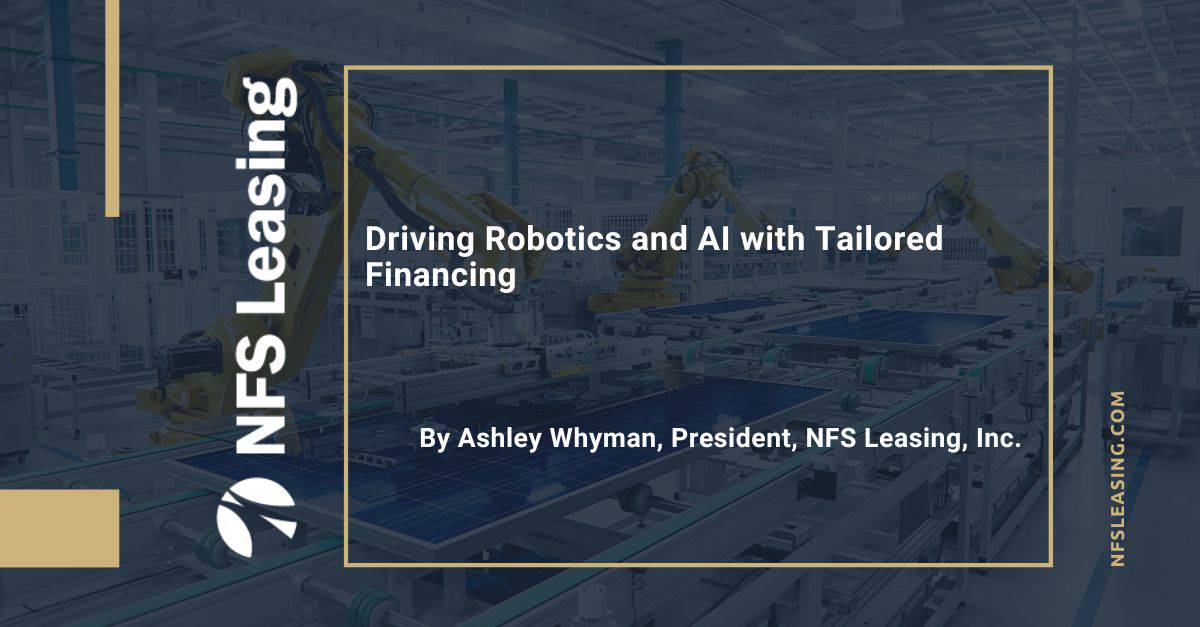
By Ashley Whyman, President, NFS Leasing, Inc., Published for industrytoday.com
As traditional lenders may limit financing for robotics and artificial intelligence, story credit lenders take a broader approach.
According to McKinsey & Co., 25% of capital spending will be directed toward automation by 2027. Still, many businesses encounter significant barriers when seeking financing from traditional lenders. Specialty lenders within the equipment leasing and financing industry recognize the growing urgency as businesses accelerate their digital transformations and strategically integrate artificial intelligence into their operations.
As our world shifts towards a more connected production environment, businesses with the right equipment can improve quality, reduce costs, increase agility, and develop products in response to evolving market demands. Advancements in robotics and automation equipment help businesses operate more efficiently, with precision and accuracy, to increase throughput. Robots can perform repetitive tasks. Artificial intelligence-driven systems can make real-time adjustments based on data inputs, leading to more consistent and high-quality outputs.
However, securing equipment financing from banks for these improvements can be challenging. This is particularly true for newer ventures with limited financial history or credit constraints. For an emerging business, being told “no” by a traditional lender can feel like a material setback—but it doesn’t have to be. Story credit lenders take a broader view, focusing on the business’s future potential and the strength of the equipment collateral.
Traditional Lending Constraints
Banks with tightened lending standards and restrictive terms are often too risk-averse to provide financing for robotics and automation, partly due to the limited historical data available. They typically look for applicants who check all the right boxes. If there is a perception of high risk, uncertainty, or other business challenges, it becomes more difficult for a business to secure bank financing.
Common obstacles include:
- Capital-intensive projects – Equipment used in medical research and robotics can be costly, and obtaining financing for it can be challenging for startups or companies with limited financial history.
- High risk/uncertainty – The biopharmaceutical and robotics industries are fast-evolving. Success isn’t guaranteed, capital requirements are heavy, R&D is lengthy, and there’s an execution risk.
- Regulatory concerns – Medical technology is heavily regulated, which can lead to delays in obtaining approvals that may impact a company’s revenue.
Story Credit Financing for Robotics and AI
The narrative changes when a specialty equipment finance company is part of the process–especially when the provider is a story credit lender. This unique type of lender considers an applicant’s potential to grow and bases equipment financing decisions on a deeper understanding of the business potential, financial projections, operating team, and the strength of the underlying collateral.
Story lenders pride themselves in supporting innovation in the modern business world and work hard to find a winning formula. They will listen to the applicant and consider their unique situation and opportunity, as well as specific goals and challenges. They gain much-needed context to try to get to a yes, whereas traditional lenders may come out of the gate with a no.
A story credit lender will consider the obstacles the business is facing to find a solution. That may be as simple as creating a structure with fixed payment terms to ease budgeting and cash-flow management. Or it may be more customized to include step-up payments for businesses expecting revenue growth or step-down payments for businesses with an initial influx of capital expected to level out over time.
It’s clear that automation can benefit a myriad of industry sectors, and now AI-driven quality control is at the forefront of automation. In construction, for example, automation has emerged with technologies such as robotic bricklaying, 3D-printed buildings, and autonomous heavy machinery. In lab and medical research, technology has enabled the creation of automated liquid-handling systems.
Story credit lenders and other specialty equipment lenders provide tailored financing that helps businesses transition to more automated operations while managing capital constraints.
These lenders are driving growth and innovation across markets and helping companies take their operations to the next level.
Keeping pace with advancing technologies is critical for businesses to stay competitive. In today’s economic environment, it is more important than ever for businesses to preserve capital to address unforeseen costs. Financing equipment is a solid option, leaving capital available for key strategic business initiatives such as R&D, product development, hiring, and marketing. Indeed, an estimated 80% of companies seeking equipment acquisition rely on financing to meet their needs, according to the Equipment Leasing and Finance Association.
In a world where staying ahead means embracing new technologies, companies are using innovative financing to reach their potential and fuel growth.
Ashley Whyman is the President of NFS Leasing, Inc., an independent equipment finance leader dedicated to empowering businesses across North America. NFS Leasing specializes in helping businesses secure the equipment they need to grow, particularly those that face challenges with traditional financing sources. By focusing on creative, story-based lending, Ms. Whyman ensures that companies of all industries and sizes can access the equipment financing necessary for their success. Recognized as one of Monitor’s “Top Women in Equipment Finance,” Ms. Whyman is an active ELFA member committed to serving businesses needing equipment financing.

